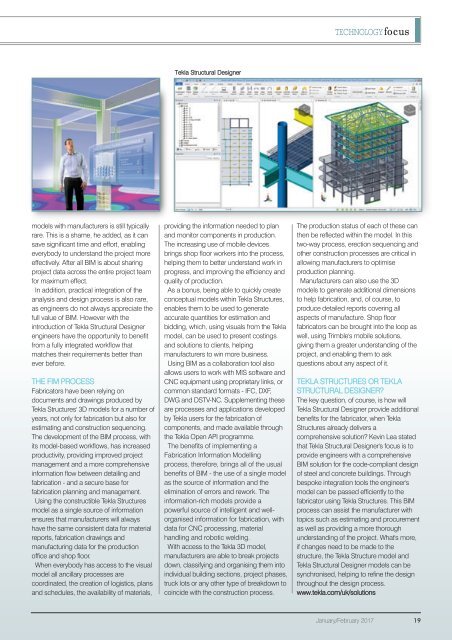CC3001
Create successful ePaper yourself
Turn your PDF publications into a flip-book with our unique Google optimized e-Paper software.
TECHNOLOGYfocus<br />
Tekla Structural Designer<br />
models with manufacturers is still typically<br />
rare. This is a shame, he added, as it can<br />
save significant time and effort, enabling<br />
everybody to understand the project more<br />
effectively. After all BIM is about sharing<br />
project data across the entire project team<br />
for maximum effect.<br />
In addition, practical integration of the<br />
analysis and design process is also rare,<br />
as engineers do not always appreciate the<br />
full value of BIM. However with the<br />
introduction of Tekla Structural Designer<br />
engineers have the opportunity to benefit<br />
from a fully integrated workflow that<br />
matches their requirements better than<br />
ever before.<br />
THE FIM PROCESS<br />
Fabricators have been relying on<br />
documents and drawings produced by<br />
Tekla Structures' 3D models for a number of<br />
years, not only for fabrication but also for<br />
estimating and construction sequencing.<br />
The development of the BIM process, with<br />
its model-based workflows, has increased<br />
productivity, providing improved project<br />
management and a more comprehensive<br />
information flow between detailing and<br />
fabrication - and a secure base for<br />
fabrication planning and management.<br />
Using the constructible Tekla Structures<br />
model as a single source of information<br />
ensures that manufacturers will always<br />
have the same consistent data for material<br />
reports, fabrication drawings and<br />
manufacturing data for the production<br />
office and shop floor.<br />
When everybody has access to the visual<br />
model all ancillary processes are<br />
coordinated, the creation of logistics, plans<br />
and schedules, the availability of materials,<br />
providing the information needed to plan<br />
and monitor components in production.<br />
The increasing use of mobile devices<br />
brings shop floor workers into the process,<br />
helping them to better understand work in<br />
progress, and improving the efficiency and<br />
quality of production.<br />
As a bonus, being able to quickly create<br />
conceptual models within Tekla Structures,<br />
enables them to be used to generate<br />
accurate quantities for estimation and<br />
bidding, which, using visuals from the Tekla<br />
model, can be used to present costings<br />
and solutions to clients, helping<br />
manufacturers to win more business.<br />
Using BIM as a collaboration tool also<br />
allows users to work with MIS software and<br />
CNC equipment using proprietary links, or<br />
common standard formats - IFC, DXF,<br />
DWG and DSTV-NC. Supplementing these<br />
are processes and applications developed<br />
by Tekla users for the fabrication of<br />
components, and made available through<br />
the Tekla Open API programme.<br />
The benefits of implementing a<br />
Fabrication Information Modelling<br />
process, therefore, brings all of the usual<br />
benefits of BIM - the use of a single model<br />
as the source of information and the<br />
elimination of errors and rework. The<br />
information-rich models provide a<br />
powerful source of intelligent and wellorganised<br />
information for fabrication, with<br />
data for CNC processing, material<br />
handling and robotic welding.<br />
With access to the Tekla 3D model,<br />
manufacturers are able to break projects<br />
down, classifying and organising them into<br />
individual building sections, project phases,<br />
truck lots or any other type of breakdown to<br />
coincide with the construction process.<br />
The production status of each of these can<br />
then be reflected within the model. In this<br />
two-way process, erection sequencing and<br />
other construction processes are critical in<br />
allowing manufacturers to optimise<br />
production planning.<br />
Manufacturers can also use the 3D<br />
models to generate additional dimensions<br />
to help fabrication, and, of course, to<br />
produce detailed reports covering all<br />
aspects of manufacture. Shop floor<br />
fabricators can be brought into the loop as<br />
well, using Trimble's mobile solutions,<br />
giving them a greater understanding of the<br />
project, and enabling them to ask<br />
questions about any aspect of it.<br />
TEKLA STRUCTURES OR TEKLA<br />
STRUCTURAL DESIGNER?<br />
The key question, of course, is how will<br />
Tekla Structural Designer provide additional<br />
benefits for the fabricator, when Tekla<br />
Structures already delivers a<br />
comprehensive solution? Kevin Lea stated<br />
that Tekla Structural Designer's focus is to<br />
provide engineers with a comprehensive<br />
BIM solution for the code-compliant design<br />
of steel and concrete buildings. Through<br />
bespoke integration tools the engineer's<br />
model can be passed efficiently to the<br />
fabricator using Tekla Structures. This BIM<br />
process can assist the manufacturer with<br />
topics such as estimating and procurement<br />
as well as providing a more thorough<br />
understanding of the project. What's more,<br />
if changes need to be made to the<br />
structure, the Tekla Structure model and<br />
Tekla Structural Designer models can be<br />
synchronised, helping to refine the design<br />
throughout the design process.<br />
www.tekla.com/uk/solutions<br />
January/February 2017 19

















